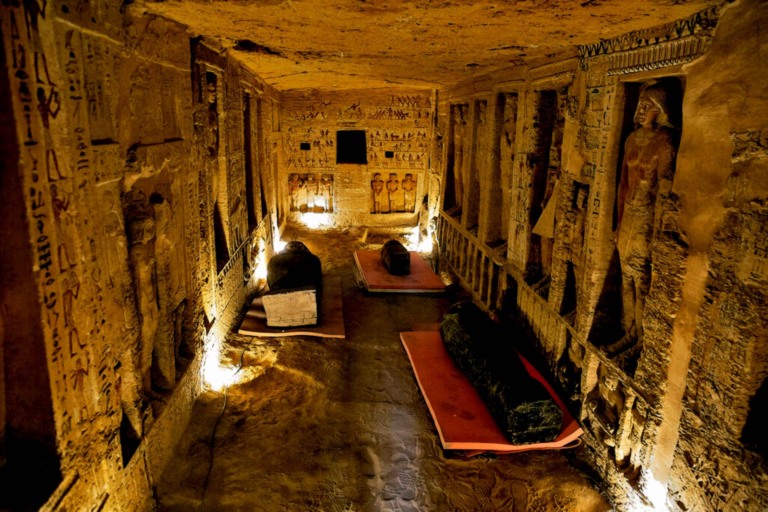The Great Pyramid of Giza is a key component of the UNESCO World Heritage site known as “Memphis and its Necropolis—the Pyramid Fields from Giza to Dahshur.” This remarkable site is situated at the heart of the Nile’s western floodplain in Egypt. It encompasses various ancient ruins, including the Pyramids of Giza, Saqqara, Dahshur, Abu Ruwaysh, and Abusir. In 1979, UNESCO collectively recognized these sites as World Heritage site.
Facts about the Great Pyramid of Giza
The Great Pyramid of Giza holds a special place within this complex. It stands as the largest Egyptian pyramid and served as the monumental tomb of Pharaoh Khufu, who ruled during the Fourth Dynasty of the Old Kingdom. Constructed in the early 26th century BC, over a span of approximately 27 years, this pyramid is not only the oldest of the Seven Wonders of the Ancient World but also the sole wonder that has remained largely intact through the ages.
The colossal structure came into existence by quarrying an estimated 2.3 million large blocks, with a total weight of around 6 million tons. These stones do not exhibit uniform size or shape and are only roughly dressed. Mortar was used to bind the outer layers together.
Local limestone from the Giza Plateau was the primary material for construction. Additionally, blocks of white limestone from Tura were transported by boat on the Nile to form the casing, while granite blocks from Aswan, some weighing up to 80 tons, were used for the structure of the “King’s Chamber.”
Great Pyramid of Giza Structure
Within the Great Pyramid, there are three known chambers. The lowest chamber was hewn from the bedrock on which the pyramid stands but remained incomplete. Above ground, within the pyramid’s structure, lie the Queen’s Chamber and the King’s Chamber, which contain a granite sarcophagus.
Hemiunu, believed to be Khufu’s vizier, is among those considered a potential architect of the Great Pyramid. Numerous scientific and alternative theories have been proposed to explain the precise construction methods employed. The funerary complex surrounding the pyramid is comprehensive. It consists of two mortuary temples linked by a causeway—one in proximity to the pyramid and another nearer to the Nile.
The area houses tombs for Khufu’s immediate family and court, including three smaller pyramids constructed for Khufu’s wives, a smaller “satellite pyramid,” and five buried solar barges. Near the pyramid, evidence of the Fourth Millennium BC Maadi culture was discovered, such as ceramic vessels, suggesting earlier settlement in the area.
Facts about the Great Pyramid of Giza built
The Great Pyramid of Giza, also known as the Pyramid of Khufu or the Pyramid of Cheops, is one of the most iconic and well-preserved pyramids in Egypt. Here are some key facts about the Great Pyramid:
1. Historical Significance: The Great Pyramid is located on the Giza Plateau, just outside Cairo, Egypt. It is one of the Seven Wonders of the Ancient World and is considered one of the most impressive architectural achievements in human history.
2. Pharaoh Khufu: The pyramid was built during the Fourth Dynasty of the Old Kingdom of Egypt, around 2580–2560 BCE, during the reign of Pharaoh Khufu (also known as Cheops in Greek). It is believed to have served as a tomb for the Pharaoh.
3. Monumental Size: The Great Pyramid originally stood at 146.6 meters (481 feet), making it the tallest man-made structure in the world for over 3,800 years. It covers an area of about 5.3 hectares (13.1 acres) at its base.
4. Architectural Precision: The pyramid is constructed with remarkable precision. Its sides are aligned almost perfectly with the cardinal points (north, south, east, and west), and the base is level to within a few centimeters. The precision of its construction techniques has long fascinated researchers.
5. Construction Techniques: The exact methods used to build the Great Pyramid are still a subject of debate among Egyptologists. It is widely believed that large limestone and granite blocks were quarried nearby and transported to the construction site. Theories about how the massive stones were moved and placed include the use of ramps, levers, and counterweights.
6. Interior Layout: The Great Pyramid has a complex interior structure, consisting of a series of passageways, chambers, and corridors. The main components include the King’s Chamber, the Queen’s Chamber, and a subterranean chamber. The purpose and symbolism of these chambers remain topics of research and debate.
7. Original Casing Stones: The pyramid originally had smooth, white Tura limestone casing stones that reflected the sun’s light, giving it a brilliant appearance. Most of these casing stones have been removed over the centuries, but a few remain at the base.
8. Alignment with Orion’s Belt: Some researchers suggest that the layout of the pyramids at Giza, including the Great Pyramid, aligns with the three stars of Orion’s Belt, a significant constellation in ancient Egyptian mythology.
9. Tomb Robberies: The Great Pyramid, like many ancient Egyptian tombs, was likely subject to tomb robberies in antiquity. When it was first opened by the Arab caliph Al-Ma’mun in the 9th century, no burials or treasures were found within.
10. Tourist Attraction: Today, the Great Pyramid is a major tourist attraction in Egypt. Visitors can explore its interior, including the King’s and Queen’s Chambers, by entering through a passageway.
The Great Pyramid of Giza continues to captivate the imagination and remains a symbol of Egypt’s rich history and ancient engineering prowess. Its construction methods and purpose remain subjects of fascination and study.



